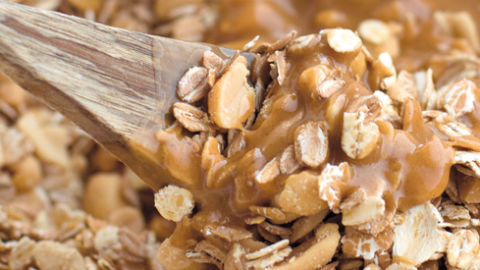Making Your Own Granola
What baked good is more versatile than granola?
Just think about how many meals are granola-appropriate occasions: enjoyed for breakfast with milk and fresh fruit, on top of yogurt as an afternoon snack, scarfed by the handful on a weekend hike, smuggled into the movie theater for a healthier alternative to candy and popcorn ….
Really, is there anywhere granola won’t go?
Once regarded as “hippie food,” this staple of 1960s health-nut culture is having a fancied-up renaissance. Now considered a boutique, small-batch artisan treat, you’ll find signature granolas at cafés and bakeries all over the Bay Area.
Even though there are plenty of great granolas for sale, I still love to make my own at home. By manipulating the proportions of the ingredients, I can create a blend with a balance of salt and sweet, full of crunchy clusters, with generous amounts of nuts and dried fruit, just the way I like it. These are, of course, my own preferences, and that’s the beauty of it—you can tweak any granola recipe to suit your tastes.
Virtually every granola follows the same basic formula, which can be broken down into three components: dry ingredients, a wet mixture to bind them together and add-ins to be folded in after the granola has cooled. The dry ingredients usually consist of rolled oats, along with raw nuts and/or seeds, and most recipes have a just over 1:1 ratio of rolled oats to nuts and seeds by volume. The wet mixture consists of oil, sweetener, salt and any spices or extracts, though low-fat recipes will sometimes replace the oil with a fruit purée. Add-ins to be incorporated after baking can include dried fruit, chocolate chips and pre-roasted nuts or seeds.
The ratio of wet-to-dry ingredients varies widely among recipes. A higher proportion of wet ingredients will yield a candy-coated, crunchy granola, while a drier recipe will be more loose in consistency, better for enjoying in a yogurt parfait but awkward to eat out of hand. I like a mix of clusters and loose granola, without the cloying sweetness of a sugar-heavy blend. To accomplish this, I employ an extra little trick, processing a small amount of the oats into a coarse flour. This helps to bind everything together without too much sugar going into the mix.
There are tons of basic granola recipes out there, waiting to be edited and tweaked into your very own custom creation. A great place to start is the “Make-Your-Own Signature Granola” in Megan Gordon’s Whole Grain Mornings. A former Bay Area resident, Megan now lives in Seattle where she runs Marge Granola, an artisanal, small-batch granola company. Her signature mix includes unique additions of ground cardamom and extra-virgin olive oil, along with plenty of salt to counterbalance the sweetness of maple syrup or honey.
When I asked Megan for a few tips, she had these three nuggets of granola wisdom to share:
1. The number one pitfall of making granola at home is overbaking it. Use a low oven temperature (300°–325°) and stir often, monitoring for color rather than texture. The granola will firm up as it cools, so don’t let its soft texture straight out of the oven fool you into thinking it needs more baking time.
2. If you like a really clumpy granola, try whisking in an egg white just before baking. This will definitely give you lots of clusters, but be aware that the shelf life may be shorter than that of a granola that doesn’t contain any eggs. Not to worry, though, as you’ll likely finish the granola long before that becomes a concern.
3. Try seasonal flavor combinations for a change from the basic. Marge Granola has two varieties just for fall, one with dried figs and cardamom, the other with chai-spiced apples, dates and walnuts.



